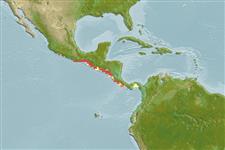ইলাসমোব্রাঙ্কি (হাঙ্গর এবং রে) (sharks and rays) >
Myliobatiformes (Stingrays) >
Urotrygonidae (American round stingrays)
Etymology: Urotrygon: Greek, oura = tail + Greek, trygon = a sting ray (Ref. 45335); nana: Named for its small adult size..
Environment: milieu / climate zone / depth range / distribution range
বাস্তুসংস্থান
সামুদ্রিক তলদেশ বিহারী. Tropical; 21°N - 8°N
Eastern Central Pacific: off central and southern Mexico; also known from Costa Rica.
আকৃতি / ওজন / Age
Maturity: Lm ? range ? - ? cm
Max length : 32.0 cm TL পুরুষ/ লিঙ্গ অনিধর্ারিত ; (Ref. 91172); common length : 15.0 cm TL পুরুষ/ লিঙ্গ অনিধর্ারিত ; (Ref. 9265)
Benthic over soft bottoms. Venomous spine on tail.
Life cycle and mating behavior
Maturities | প্রজনন | Spawnings | Egg(s) | Fecundities | শুককীট
McEachran, J.D., 1995. Urolophidae. Rayas redondas. p. 786-792. In W. Fischer, F. Krupp, W. Schneider, C. Sommer, K.E. Carpenter and V. Niem (eds.) Guia FAO para Identification de Especies para lo Fines de la Pesca. Pacifico Centro-Oriental. 3 Vols. FAO, Rome. (Ref. 9265)
IUCN Red List Status (Ref. 130435)
Threat to humans
Venomous
Human uses
হাতিয়ার
Special reports
Download XML
ইন্টারনেট সুত্র
Estimates based on models
Preferred temperature (Ref.
123201): 23.4 - 29, mean 27.8 °C (based on 44 cells).
Phylogenetic diversity index (Ref.
82804): PD
50 = 0.5001 [Uniqueness, from 0.5 = low to 2.0 = high].
Bayesian length-weight: a=0.01000 (0.00484 - 0.02068), b=3.07 (2.88 - 3.26), in cm total length, based on LWR estimates for this species & (Sub)family-body (Ref.
93245).
ট্রফিক পর্যায়ে (Ref.
69278): 3.7 ±0.6 se; based on size and trophs of closest relatives
স্থিতিস্থাপক (Ref.
120179): নিম্ন/ , সর্বনিম্ন প্রজন দ্বিগুনের সময় ৪.৪-১৪ বৎসর (Assuming fecundity<100).
Fishing Vulnerability (Ref.
59153): Low vulnerability (22 of 100).
